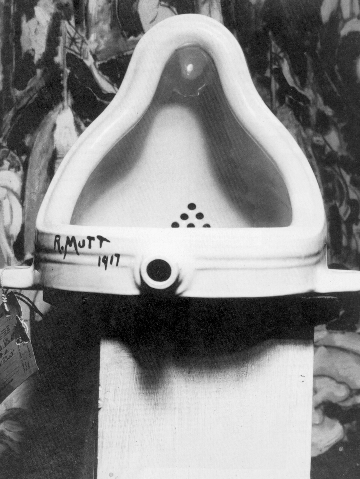
Pictured above is a urinal.
It is also my favorite work of art.
Perhaps a little bit of history is needed to understand why this is so. Marcel Duchamp was a very famous Modern artist; a celebrity of his time. He tore down the old and ushered in a new era of symbolic art and Dadaism. His work included such pieces as L.H.O.O.Q.—nothing more than a poster reproduction of the Mona Lisa with a moustache drawn on and a caption that sounded like “she has heat in the ass” in French. His genius was admired far and wide, even if it wasn’t truly understood.
Duchamp realized how ludicrous his fame had become, and set out to prove that the nature of art had changed. No longer was it about verisimilitude, aesthetic appeal, or even social commentary. Instead, it had simply become a measure of the popularity of the artist (what Andy Warhol would call the fifteen minutes of fame).
To test his theory, Duchamp took the above porcelain, christened it “Fountain,” and signed the name R. Mutt with a bold flourish. He then tried to get it exhibited in a respected art show. People were outraged at the submission of such a monstrosity, and denied its access to the gallery. They did not recognize the name of this Mutt fellow, and therefore condemned his artwork as trash. Once Duchamp stepped forward and took credit for the piece, however, the whole scenario was written off as a good joke and Fountain was elevated to the level of a true masterpiece. Such is the irony of the avant-garde.
Art defines a society, and a society defines its art. It is inseparable from philosophy and social commentary. Take a look around—observe the things consider beautiful. How do you decorate your home? What does that say about your values, your beliefs, and your culture? This could be an interesting experiment….
....and I just realized I sound like a high school history teacher. I apologize for that. I tend to get a little over-excited on topics such as this.

No comments:
Post a Comment